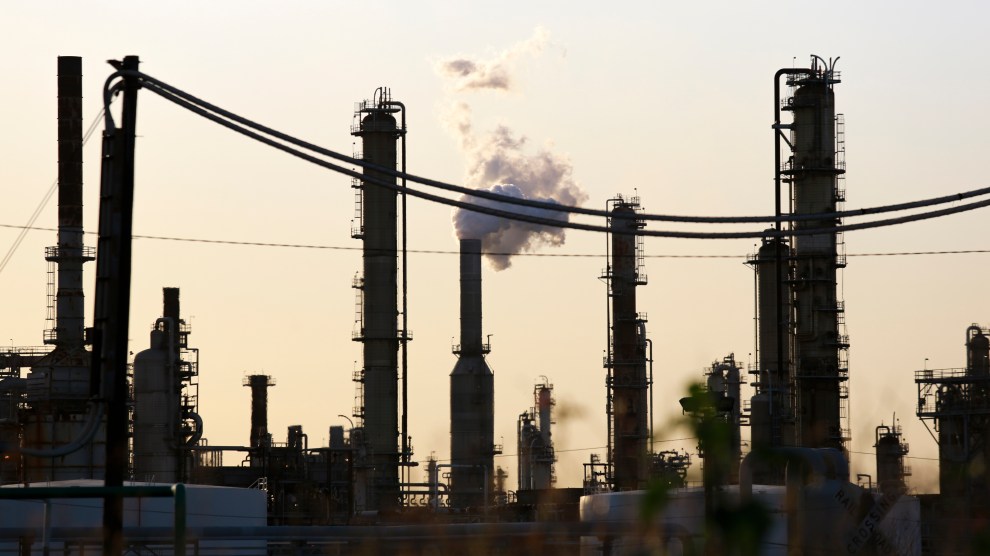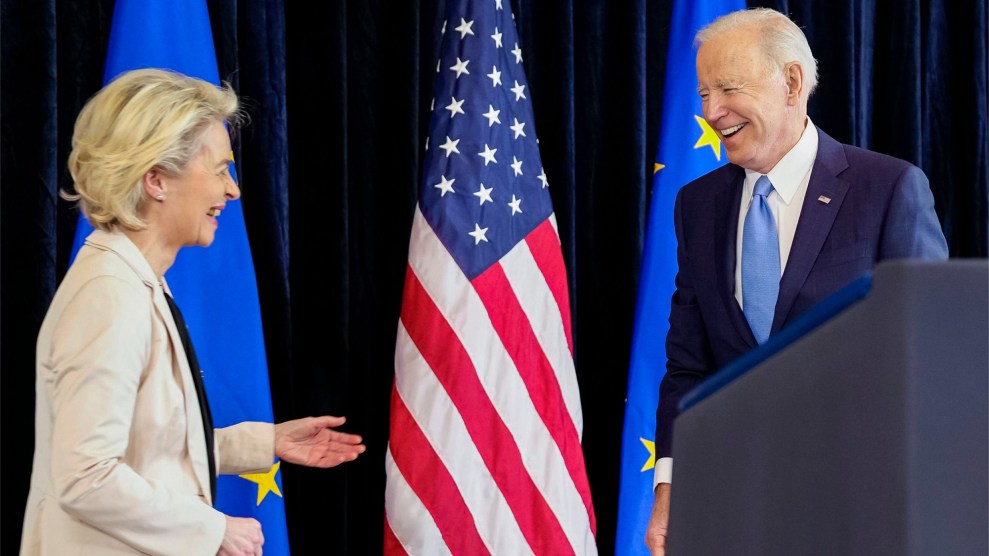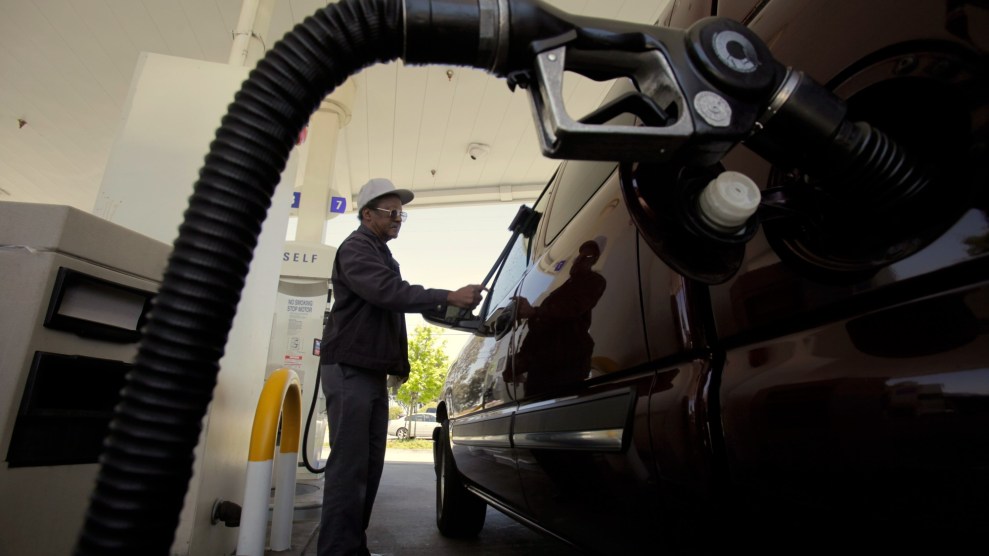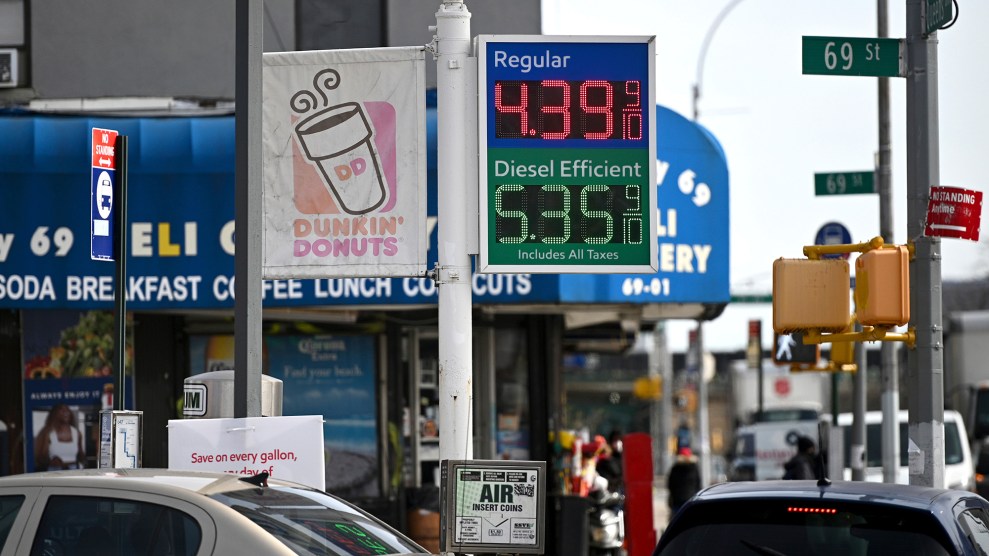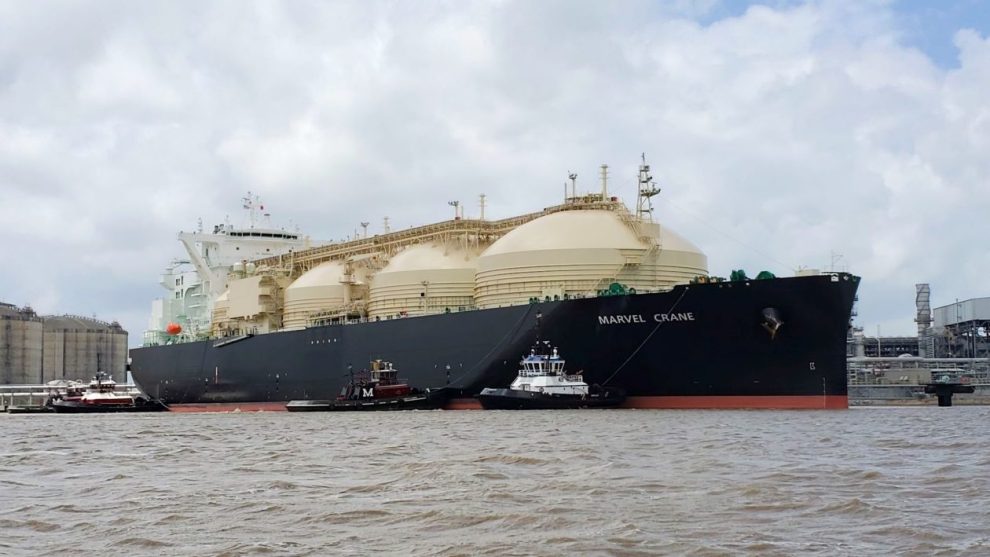
The Marvel Crane, a liquid natural gas carrier, at an LNG terminal in Hackberry, Louisiana.US Coast Guard/Flickr
This story was originally published by Yale E360 and is reproduced here as part of the Climate Desk collaboration.
In the span of weeks, Russia’s war on Ukraine has created millions of refugees, transformed the geopolitical landscape, upended global energy markets and food supply chains, and hastened Europe’s efforts to transition away from fossil fuels. The war also threatens to alter the trajectory of energy and climate policy in the United States.
On March 25, a month after Russia launched its invasion, President Biden met with European Commission President Ursula von der Leyen in Brussels and jointly announced a new initiative to help Europe reduce its reliance on Russian fossil fuels. Their plan calls for boosting exports of liquefied natural gas (LNG) from the US to the European Union by 15 billion cubic meters this year and as much as 50 billion cubic meters—a third of what Europe currently buys from Russia—by 2030.
Biden administration officials have characterized the LNG surge as a stopgap measure to help Europe bridge these next few years until it can build more renewable energy and make its buildings and industries more energy efficient. But energy analysts say the announcement could signal a pivot toward greater support for expanding gas infrastructure, potentially locking in significant new sources of greenhouse gas emissions.
New LNG terminals—whether for export on the US Gulf Coast or for import on Germany’s North Sea coast—would take several years and several billion dollars to build. Analysts say that by the time they are up and running, the geopolitical environment may look different, but climate change will be all the more urgent, and there will be powerful business incentives to keep the terminals operating.
“Europe needs more US LNG to get through the next two winters, not incentivization to use gas for the next 20 years,” said Claire Healy, of the energy think tank E3G, in a statement. “It has turned a short-term energy crunch into a long-term crutch for American oil and gas producers.”
Some energy experts caution that expanding LNG infrastructure would be a distraction from more durable solutions to promote energy security in both the US and the EU. Rather than boosting supply by building LNG projects that could become stranded assets, they say, countries should focus on energy efficiency and other ways to reduce demand for gas.
Even with new terminals, LNG from the US won’t be able to replace the massive volume of gas that Europe imports from Russia, either today or in 10 years, said Maria Pastukhova, a Berlin-based senior policy advisor with E3G. “That’s why the focus on demand is so crucial.”
Two recent analyses contend that the US can help Europe shut off the spigot of Russian gas within the next few years while also resisting the industry’s calls to expand gas infrastructure.
New US LNG export facilities aren’t needed to meet the Biden-EU targets, according to Clark Williams-Derry of the Institute for Energy Economics and Financial Analysis (IEEFA). He authored a recent analysis showing that the combined capacity of the LNG export terminals in the US currently operating and under construction is more than sufficient to reach the aim of an additional 15 billion cubic meters by the end of 2022 and 50 billion by 2030.
“They were already on track to blow through that goal of 15 billion cubic meters this year, and maybe even get close to the 50 billion cubic meter target this year,” Williams-Derry said, referring to US LNG exporters. “Which means that the goal itself doesn’t add anything new to the conversation.”
Another report, produced by E3G in collaboration with several other energy think tanks, outlines near-term measures that can be taken to slash Europe’s demand for gas. The analysis finds that deploying more clean energy, electrifying heating and industrial processes, and improving energy efficiency could cut Russian gas imports by two thirds by 2025, blunting the need for the US to export more gas.
As is, the US is expected to become the world’s largest exporter of LNG this year. It has six LNG export terminals that together move around 100 billion cubic meters of gas per year. These facilities—designed to shrink natural gas to a volume 600 times smaller by supercooling it into liquid form—were built to take advantage of the enormous glut of gas unlocked from shale formations since drillers started deploying fracking technology in the mid-2000s.
Two more terminals are on the way: Calcasieu Pass on Louisiana’s Gulf Coast and Golden Pass, located about 50 miles west on the Sabine River just south of Port Arthur, Texas. An analysis from EIA projects that, with new gas liquefaction facilities already under construction and growing foreign demand for gas, US LNG exports will exceed 165 billion cubic meters by 2033.
Long before Russia’s war on Ukraine, there were growing concerns that additional LNG export terminals would lock in climate-warming pollution for decades to come. A report published by the Natural Resources Defense Council estimated that greenhouse gas emissions from the full process of extracting, processing, transporting, and liquefying natural gas will be equivalent to the emissions of up to 45 million cars by 2030. Leaks of methane—a potent greenhouse gas trapping 80 times as much heat as carbon dioxide over a 20-year time span—account for a large portion of those emissions.
Last fall, the US led the launch of the Global Methane Pledge at the UN climate meeting in Glasgow, in which more than 100 countries promised to cut their methane emissions by 30 percent by 2030. Climate advocates are pushing the Biden administration to explain how it intends to reconcile that call to action—and its own climate targets of halving greenhouse gas emissions over the next decade—with the plan to boost gas exports out to 2030.
The Intergovernmental Panel on Climate Change’s most recent report makes it clear that no new fossil fuel infrastructure can be built if the world is to stay under 1.5 degrees Celsius of warming. Investing in any new fossil fuel development, said United Nations Secretary-General Antonio Guterres on the day of the report’s release, “is moral and economic madness.”
For climate advocates, it has been jarring to watch US Secretary of Energy Jennifer Granholm and other Biden administration officials ask oil and gas firms to increase production to help counter a surge in prices and shore up European allies. “Clearly LNG is a big part of this equation,” Granholm told energy executives assembled for a conference in Houston in March. “We have got to do our part to ensure that others are not hurting.” She pledged that the administration would look at ways to “collapse the bureaucracy” around permitting for new projects.
Industry trade associations such as the American Petroleum Institute and the Center for Liquefied Natural Gas were quick to celebrate the Biden-EU deal and to use it to amplify their longstanding push for more natural gas infrastructure and fewer regulatory hurdles. “We stand ready to work with the administration to follow this announcement with meaningful policy actions to support global energy security,” Mike Sommers, CEO of the American Petroleum Institute, said in a statement, “including further addressing the backlog of LNG permits, reforming the permitting process, and advancing more natural gas pipeline infrastructure.”
The industry has complained about burdensome regulations, but a lack of federal permits is not holding back development of new LNG terminals or pipelines to supply them. The Federal Energy Regulatory Commission and Department of Energy have issued approvals for 13 different liquefaction projects that have not broken ground because their developers have not been able to secure financing for them.
Building new LNG facilities—which include pipelines to supply natural gas, liquefaction units to chill it to minus 260 degrees F, and specialized docks for loading it onto 1,000-foot-long tanker ships—is a long and expensive undertaking. Before footing the bill for construction, banks typically want to see a slate of long-term contracts with foreign buyers that accounts for most of a project’s future gas output.
Investors have been holding back in recent years, mindful of the Covid-induced crash in natural gas demand in 2020 and the risk that climate policies implemented later this decade could suppress longer-term demand in many markets. “The infrastructure you start now may wind up being an albatross in three or four years,” said IEEFA’s Williams-Derry.
Proposed LNG export infrastructure won’t be sending gas to Europe any time soon. But a push from governments could change that.
Energy analysts say that if policymakers pivot toward supporting new gas infrastructure, that could stymie investments in clean energy and energy efficiency in both the US and Europe. Pastukhova worries that governments might provide loan guarantees and pressure their development banks to facilitate new LNG project investments, which are fraught with risks because of the mismatched timelines of 20-year-contracts required by investors in LNG terminals and looming 2030 international emissions reduction deadlines.
“If this happens and governments give in to the push by industry, we end up with public finance sunk into assets that are stranded from the beginning, leaving much less space to invest in the accelerated energy transition,” Pastukhova said. “And we really need every cent of this public finance for that transition.”
As the evidence of brutal attacks on Ukrainian civilians by Russian forces mounts by the day, the pressure on European leaders—particularly in Germany, which is heavily dependent on Russian gas—to impose an embargo on Russian energy imports is mounting. European countries send Gazprom and other government-controlled firms in Russia about $850 million for gas and oil every day. In early April, the EU’s top diplomat said that since Russia’s invasion began, the EU has sent 35 billion euros to Russia for energy, while it has sent just 1 billion euros in aid to Ukraine.
Experts say that the multiple imperatives of cutting emissions, supporting allies abroad, and achieving energy security at home, all point toward the same answer: using less natural gas.
“There is this very traditional perception of energy security as security of supply,” Pastukhova said. “But what’s happening in energy markets is this emerging understanding that it’s about security of both supply and demand.”
Research from Jesse Jenkins, an assistant professor and energy systems expert at Princeton University, suggests that while increasing and rerouting LNG shipments to Europe will help now, implementing the climate-focused elements of Biden’s long-stalled Build Back Better bill would enable more robust support for Europe’s struggle to wean itself off Russian gas over the next few years.
Jenkins and colleagues modeled the impact of a clean energy investment package equivalent to that in the bill and found it would cut domestic gas use by 57 billion cubic meters by 2028. That, in turn, would free up US natural gas supplies for export using existing LNG infrastructure—giving European policymakers the confidence to pivot away from Russian energy, while insulating US consumers and businesses from global price shocks resulting from increased demand.
Without such steps, high natural gas prices could make increasing LNG exports out to 2030 both economically and politically unsustainable. Part of the reason natural gas prices are surging now, Williams-Derry said, is the recent increase in LNG exports.
“Ultimately we solve this on the demand side,” Jenkins said. “And we do it by making alternatives on the demand side better—cheaper, better, more convenient—in the context of a large investment package in clean energy, and in accelerating US demand away from oil and gas. And in a context where the EU is doing the same thing.”
